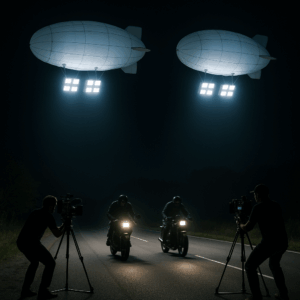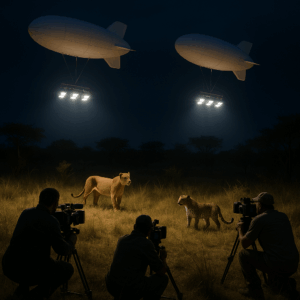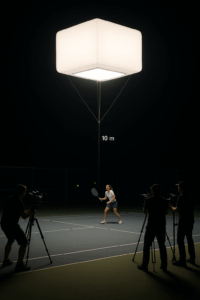Lighting has always been a critical element in filmmaking—defining mood, shaping perception, and guiding the viewer’s eye. In recent years, the industry has witnessed the rise of a revolutionary solution that floats above the traditional limitations: helium balloon LED lights. These luminous, suspended systems are rapidly becoming essential tools on both large-scale productions and indie sets, offering soft, consistent, and highly controllable lighting in a mobile and unobtrusive format. As technology continues to evolve and filmmakers seek more flexible lighting solutions, helium balloon LEDs are redefining what is possible on set.
The film industry has seen its lighting technologies evolve dramatically. Tungsten lamps, once a staple, gave way to HMIs and eventually to LED fixtures due to their energy efficiency, low heat generation, and long lifespan. Yet, even LED panels have limits in mobility and softness of light. Traditional lighting setups often require a variety of modifiers like softboxes, scrims, and bounce boards to achieve desired lighting conditions.
Originally used for construction or emergency lighting, helium balloon lights caught the attention of filmmakers for their soft, ambient glow and ability to illuminate large areas without harsh shadows. When combined with advanced LED technology, they become a highly versatile tool capable of addressing multiple lighting challenges in a single setup. Their development marks a convergence of portability, aesthetic control, and environmental consciousness.
Helium balloon LEDs typically consist of a durable, inflatable balloon filled with helium gas, with an array of high-efficiency LED modules inside or mounted around the perimeter. They may come in spherical, cylindrical, or cube shapes, with varying color temperatures and dimming options. The materials used are often flame-retardant and UV-resistant, ensuring both safety and durability.
Helium balloon LEDs come in various sizes ranging from small 60cm diameter units to large 2-meter diameter systems capable of lighting vast areas. Most setups are modular, allowing gaffers to choose configurations based on shoot requirements.
One of the primary reasons DPs (Directors of Photography) love helium balloon LEDs is the quality of light. Their large surface area provides a naturally soft output, minimizing harsh shadows—ideal for night scenes, dialogue close-ups, or moody landscapes. This softness helps to maintain the integrity of actors’ faces, reduce retouching in post, and enhance realism in emotionally intimate scenes.
Unlike traditional lighting setups that require multiple stands, arms, and modifiers, balloon lights float above the action, eliminating clutter on set. This makes them invaluable for tight spaces or scenes involving moving actors, vehicles, or complex camera movements. A cleaner set also contributes to improved safety and fewer obstructions for camera operators.
Time is money on set. Helium balloon LEDs require far less rigging and positioning than traditional light sources. Many models can be set up in under 30 minutes, making them a favorite for run-and-gun productions, on-location shoots, and documentary filmmakers working with limited crews.
Whether suspended above a street for a night scene or used in a studio to mimic overhead skylight, balloon LEDs perform well in a wide range of environments. Their adaptability makes them suitable for commercials, TV series, feature films, and even live events, such as concerts or festivals, where rapid lighting changes and soft wash effects are needed.
Because they rely on LED technology, helium balloon lights consume significantly less power than HMIs or tungsten lights. This not only reduces fuel costs and generator loads but also aligns with the growing push for eco-friendly film production.
 IV. Real-World Use Cases
IV. Real-World Use CasesMovies like The Revenant, 1917, and Blade Runner 2049 have employed balloon lighting to create naturalistic night scenes or diffuse large outdoor sets. These lights allow DPs to simulate moonlight or replicate overcast skies with total control. In TV dramas where multiple angles are required, helium balloon lights provide consistent coverage without the need for constant re-rigging.
Photographers and fashion filmmakers appreciate the color fidelity and shadowless quality of balloon LEDs. For outdoor fashion editorials or car commercials, these lights ensure uniform lighting that flatters both models and reflective surfaces. They’re particularly popular in luxury shoots where skin tone accuracy and high production value are critical.
In high-risk, fast-paced sequences—especially those involving stunts, water, or explosions—balloon lights offer unobstructed lighting without posing physical hazards or interfering with choreography. Their height-adjustability allows lighting to follow the action from a safe distance, ensuring visibility without endangering cast or crew.
For field reporters and documentary crews working in remote locations or disaster zones, helium balloon lights provide mobile, powerful lighting solutions. Some models are equipped with battery-powered LED arrays, making them perfect for areas with unreliable power sources.
Most helium balloon LEDs can be powered via AC power, batteries, or portable generators, with low power consumption compared to older lights. Integrated DMX control systems enable real-time adjustments in intensity and color, ensuring flexibility during shooting. Some newer models also offer wireless control via smartphone or tablet apps.
Modern balloon lights are constructed from fire-retardant, UV-resistant materials, and many models are IP-rated for wind and rain resistance. Anchoring systems and backup tethers are used for safety, especially in outdoor or elevated setups. Built-in sensors can also automatically reduce brightness or initiate safe shutdown protocols in adverse weather conditions.
Helium balloons are lightweight when deflated and easy to pack. Inflation typically takes 5–15 minutes using standard helium tanks. Maintenance is minimal—just occasional cleaning and checks for leaks or wear. Balloons are reusable for hundreds of setups, making them a long-term asset for rental houses and production companies.
While initial costs for helium balloon LED systems may be higher than basic LED panels or fresnels, the return on investment is significant. Reduced setup time, smaller crews, lower power draw, and the versatility of one unit replacing multiple lights make them cost-effective over time.
Additionally, their visual appeal and cinematic quality enhance the overall production value, which can translate into better distribution opportunities, audience engagement, and critical acclaim. For rental houses, the uniqueness of balloon lights also represents a competitive advantage.
As LED and battery technology continue to evolve, we can expect even more compact, efficient, and feature-rich balloon lights. Integration with drones is already in experimental stages, allowing even more dynamic lighting solutions for scenes that require moving light sources.
Future models may integrate AI-driven lighting controls, allowing balloon LEDs to adjust their intensity, color, or direction based on the movement of actors or changing weather. Real-time metadata feedback from cameras could further enhance dynamic scene lighting.
With RGBWW balloon LEDs, filmmakers can create stylized color environments or simulate multiple light sources from a single balloon. This opens up new creative avenues for sci-fi, fantasy, or stylized dramas, all without increasing on-set complexity.
Helium balloon LED lights are more than just a new gear trend—they represent a shift in how filmmakers approach lighting. With their ability to provide soft, uniform, and flexible illumination from above, they are transforming film sets from cluttered, static lighting zones into open, fluid creative spaces.
In an industry where light is storytelling, helium balloon LEDs are enabling stories to be told with greater freedom, clarity, and artistry—lighting not just the sky, but the path forward for cinematography.
Get in touch for free lighting customization